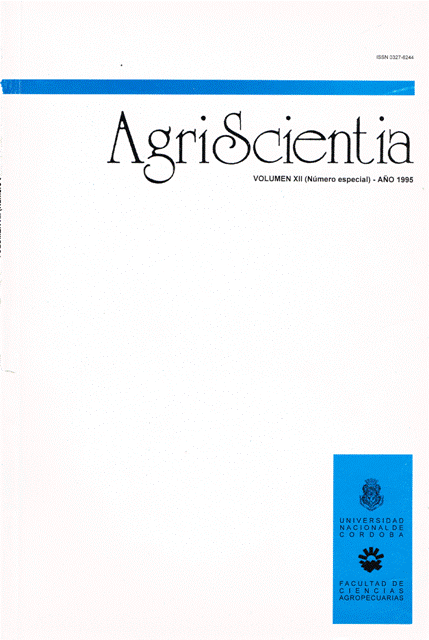Rhizosphere temperature in maize: influence of moisture status
Main Article Content
Abstract
Soil temperature is a main factor for germination, emergence, and growth of plants. Local interest in the soil temperature-moisture relationship is found in the recent popularization of complementary irrigation for corn production. The present paper reports results of a field experiment in which air temperature (0.50 m) and soil temperature (-0.05 m and -0.25 m) were recorded during 60 days from seedling emergence. Discussion is based on two levels of soil moisture status. Differences are detected in maximum, medium, and minimum temperatures among irrigated and unirrigated plots. Maximum and minimum soil temperatures at the superficial level (-0.05 m) differed by 1.53 °C and 1.57 °C in both treatments. Maximum and minimum air temperatures were lower in irrigated plots. Hypothetic influence of soil moisture status over soil and near-atmosphere temperatures is confirmed. With these experimental conditions, we don't find phenology effects on maize plants.
Article Details

This work is licensed under a Creative Commons Attribution-ShareAlike 4.0 International License.
How to Cite
References
AI-Derby, A. M., & Lowery, B. (1987). Seed zone soil temperature and early corn growth with three conservation tillage systems. Soil Science Society of America Journal, 51, 768-771.
Benech Arnold, R. L., Ghersa, C. M., & Schlichter, T. M. (1987). Simulación de flujo de calor en el suelo. Evaluación de métodos numéricos. Ciencia del Suelo, 5(2), 105-115.
Coelho, D. T., & Dale, R. F. (1980). An energy-crop growth variable and temperature function for predicting corn growth and development: Planting to silking. Agronomy Journal, 72, 503-510.
Del Barrio, R. A., & Asborno, M. D. (1988). Régimen agroclimático de temperaturas mínimas cercanas al suelo en la localidad de Castelar (Buenos Aires). En Actas del II Congreso Iberoamericano de Meteorología (Buenos Aires).
Hanway, J. J. (1966). Growth stages of maize/corn. U.S. Department of Agriculture Technical Bulletin 976. Spec. Rep. 48, Iowa State University.
Navarro Farías, E. (1994). Física de suelos con enfoque agrícola. México: Editorial Trillas.
Pecorari, C. A., & Balcaza, L. (1986). Reserva de agua útil en algunas series de suelos de la Pampa Ondulada. Carpeta de Producción Vegetal - Serie Generalidades. Información N° 50. Tomo VII, INTA Estación Experimental Agropecuaria Pergamino.
Pellerin, S., & Pages, L. (1994). Evaluation of parameters describing the root system architecture of field-grown maize plants (Zea mays L.). 1. Elongation of seminal and nodal roots and extension of their branched zone. Plant and Soil, 164, 155-167.
Rebella, C. M., & Zeljkovich de, L. T. (1980). Probabilidades de deficiencias y excesos hídricos en la región de Pergamino. En Actas de la IX Reunión Argentina de Ciencia del Suelo (Tomo I, pp. 79-85).
Russel, J., & Russell, E. W. (1968). Las condiciones del suelo y el crecimiento de las plantas. España: Editorial Aguilar.
Troeh, F. R., Hobbs, J. A., & Donahue, R. L. (1980). Soil and water conservation. Englewood Cliffs, New Jersey, USA: Prentice-Hall, Inc.
Vogelezang, J. V. M. (1992). Effect of root zone and air temperature on flowering and growth of Spathiphyllum and Guzmania minor Empire. Scientia Horticulturae, 49, 311-322.





